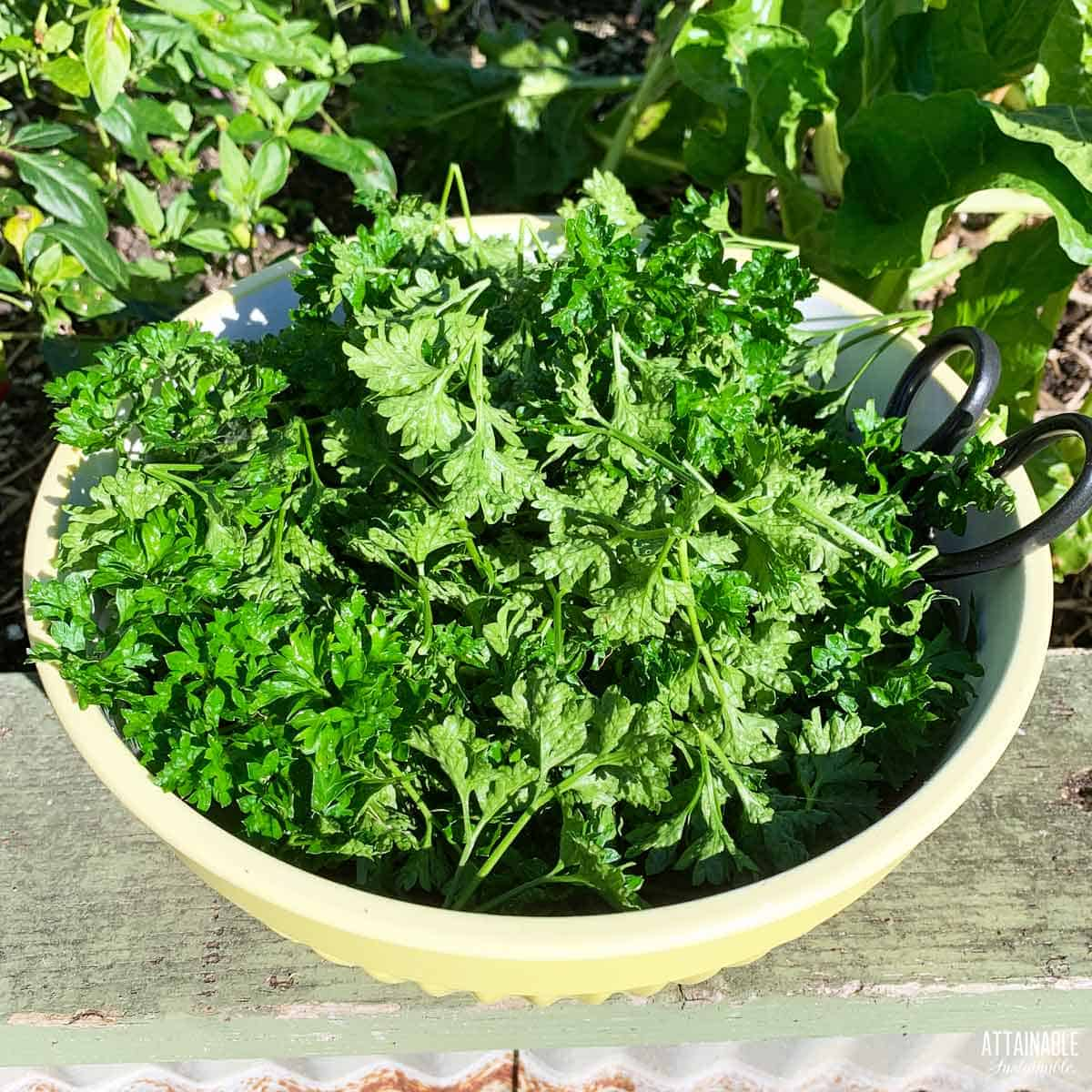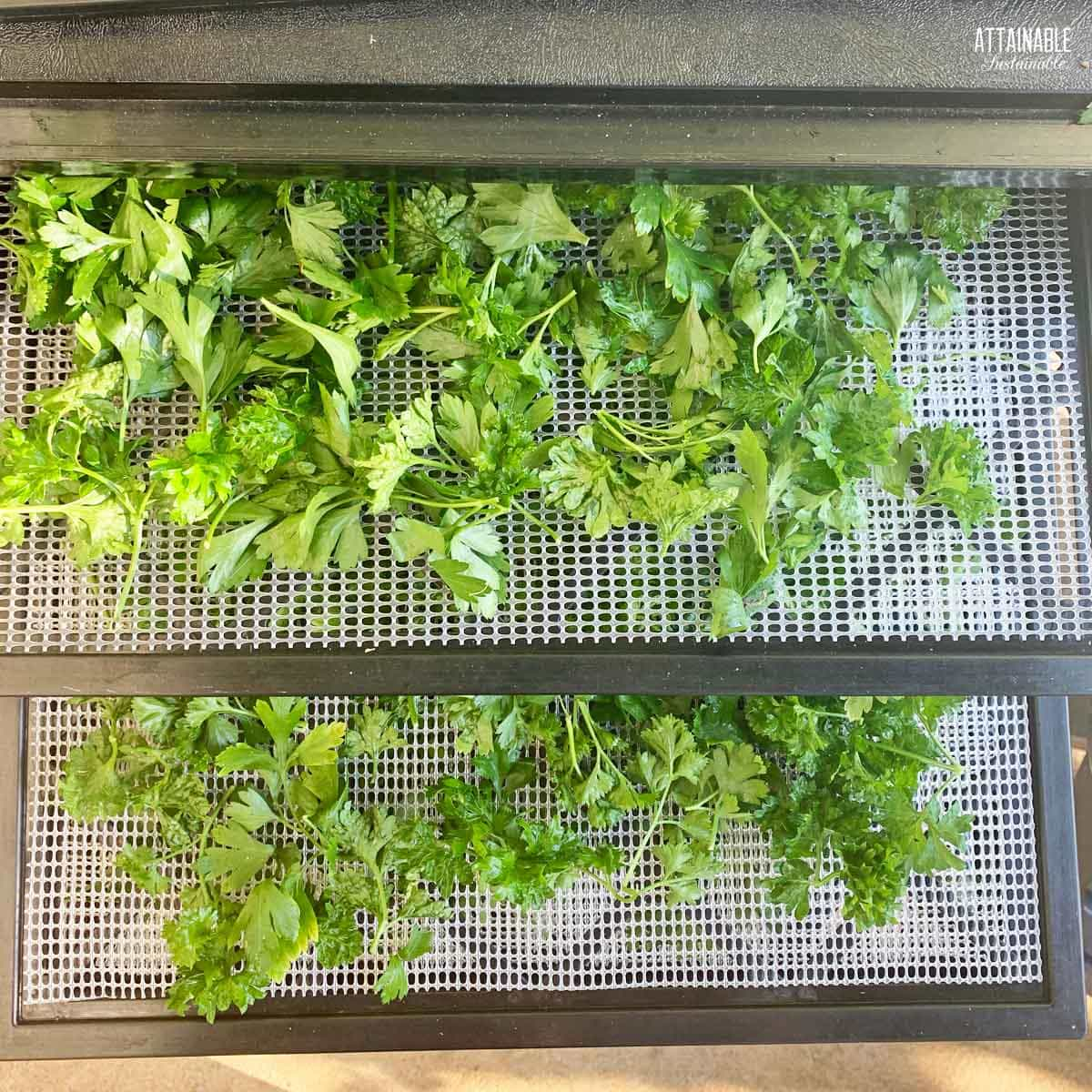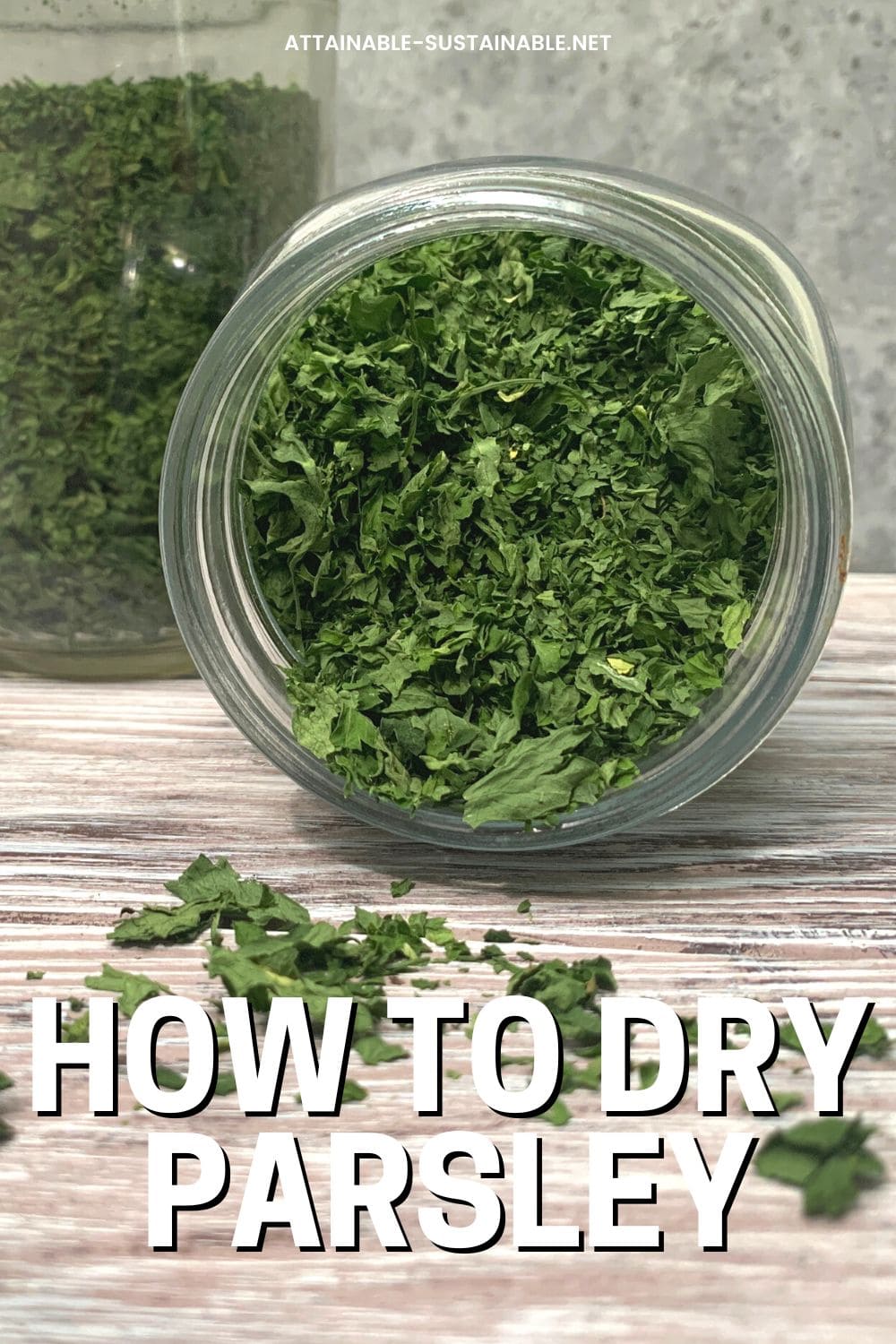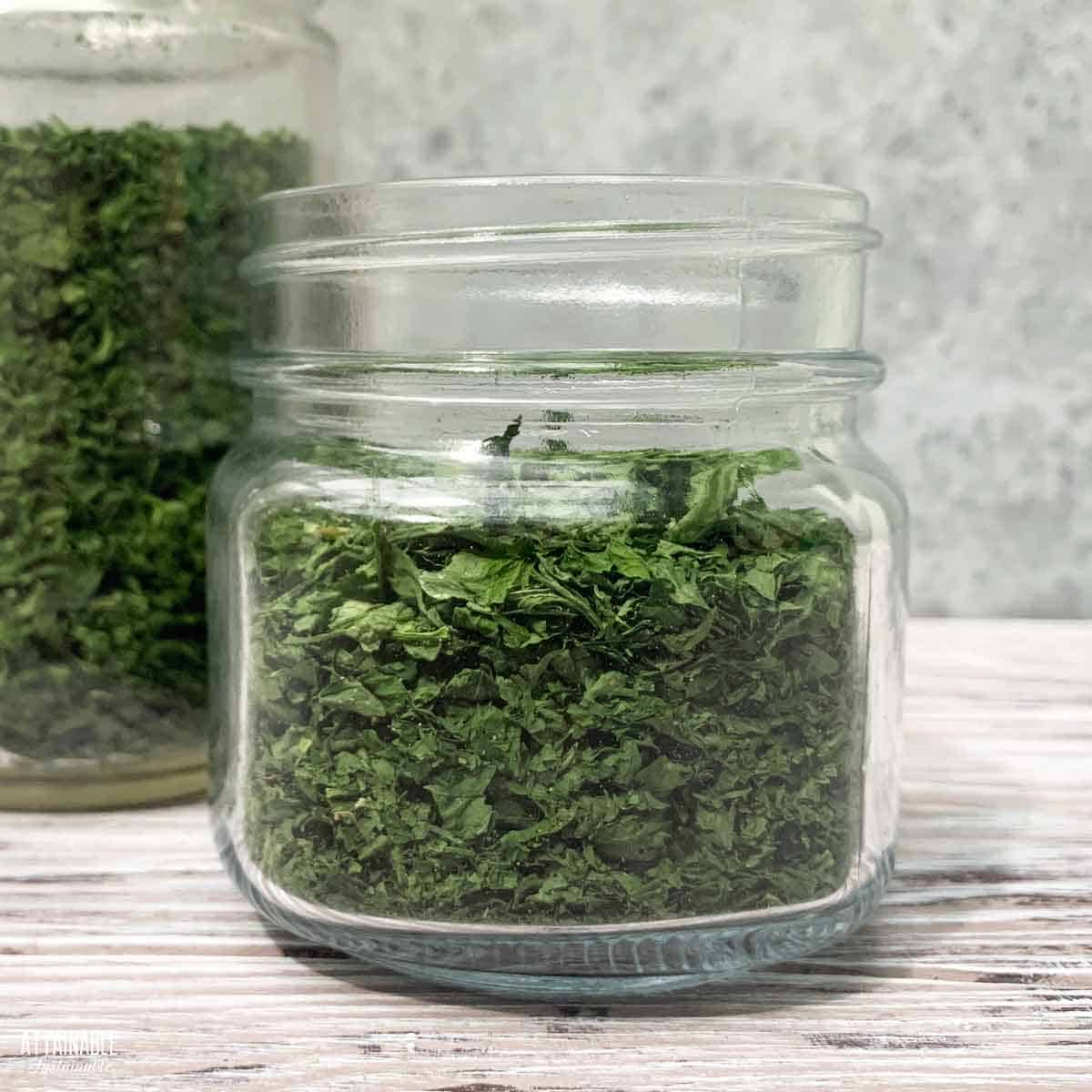Dried herbs from the grocery store can be expensive. If you’re growing parsley in your herb garden, you probably cut it to use fresh when you can, for both flavoring recipes and as a garnish. You can also harvest the leaves to dry your own parsley.
Parsley is an incredibly versatile herb, adding a deep herbal flavor to many savory dishes without being overpowering. It is a must-have for your spice cabinet. Out of all the leafy dry herbs I keep on hand, this one gets used most frequently in my household.
Preserving Parsley
A lush, green parsley plant is ripe for picking. Use scissors to cut the stems close to the base of the plant. Leave the trimmed plant in the ground or pot; it will send out fresh leaves from the base as long as the weather is right. (More about growing parsley here.)
These instructions work for both flat-leaf parsley and curly parsley. Flat leaf parsley does tend to lay flatter in the dehydrator, though.
Preparing Parsley for Drying
Before drying your fresh parsley leaves, you need to prepare them. Wash the leaves by submerging stems of parsley into a big bowl of water. Swish them around a bit, making sure that they’re all submerged, and allow to sit for 15-20 minutes. Swish again, and lift parsley into a colander to drain.
5 Easy Steps to Transform Your Pantry!
Ready to switch from store bought to homemade? Let me help you make some changes! Grab my FREE five-part guide to getting started.
Transfer drained parsley leaves to a towel. Cover with a second towel and roll up the two towels with the parsley sandwiched in between to remove as much excess moisture as possible. You could also use a salad spinner to remove moisture.
Remove leaves from the parsley stems. The stems can go into your compost bin or be added to stock recipes; the whole parsley leaves are the part to be preserved.
How to Dry Parsley
The length of time it takes for parsley to dry will depend entirely on the temperature, humidity, and method used.
Using a Dehydrator
A food dehydrator offers a more controlled environment for drying fresh herbs. It’s my preferred method, though it’s not the only way to do it.
To dry parsley in a food dehydrator, spread a single layer of parsley leaves on dehydrator trays. Position them so that they’re close together but not overlapping. This allows for free air flow.
Set dehydrator to lowest heat setting (some dehydrators have an “herb” setting). The ideal temperature is 95 degrees, which will slowly dry out the leaves without cooking them.
How long it takes to dehydrate parsley will vary greatly based on the humidity of your region. Begin checking parsley after about six hours, though depending on your climate, this can take as long as 8 or 10 hours.
Drying Fresh Parsley in the Oven
You can dry parsley in your oven, though the minimum oven temperature that some ovens have aren’t ideal. The best way to do it is to use the bread proofing setting if you have a newer oven.
If your oven doesn’t have a bread proofing setting, turn it onto its lowest setting and prop the oven door open to avoid overheating.
Line a baking tray or cookie sheet with a kitchen towel and place leaves in a single layer so that they barely touch. Transfer trays to the oven and dry for two to four hours, keeping a close eye on the drying leaves when they begin to dry out.
Air Drying Parsley
If your climate is dry and hot, the simplest way to dry parsley leaves is to use what Mother Nature offers up. You can air dry parsley the old-fashioned way if you have the space.
Instead of removing the leaves from the stems, leave the stems long and make small bundles, binding them together with a twist tie or a rubber band.
Hang parsley to dry on rafters at room temperature, or stretch a length of sturdy line on a fence out of direct sunlight or across the ceiling. Use clothespins to hold herb bundles in place.
Optionally, you can cut a slit in the bottom of a small paper bag and push the stiff stems into the bag and through the slits so that the bundle of herbs is covered by the bag. This helps keep dust off the herbs as the leaves dry.
An Unorthodox Method to Dry Fresh Parsley
Spread parsley on baking sheets as you would for oven drying. Instead of turning the oven on, set the trays of parsley leaves inside your car. The heat from sitting in the sunshine will work just as well as any dehydrator without using electricity or gas.
When are the Leaves Done?
Test the leaves by crushing them in your hand. If the parsley is dry enough, it should crumble easily into small pieces. If they just roll or bend or wrinkle in your hand, they still need more time.
It will be fairly obvious which leaves need more time. Return those to the tray and continue drying until they reach peak crispiness.
When the parsley leaves are crispy, rub them between your fingers to crush them for storage.
Store dehydrated parsley leaves in an airtight container in a dry place I like to use upcycled glass jars or a Mason jar with a leakproof lid (these are more airtight than a lid and ring). Adding a desiccant packet can help maintain freshness. Store jars of parsley in a cool, dark place.
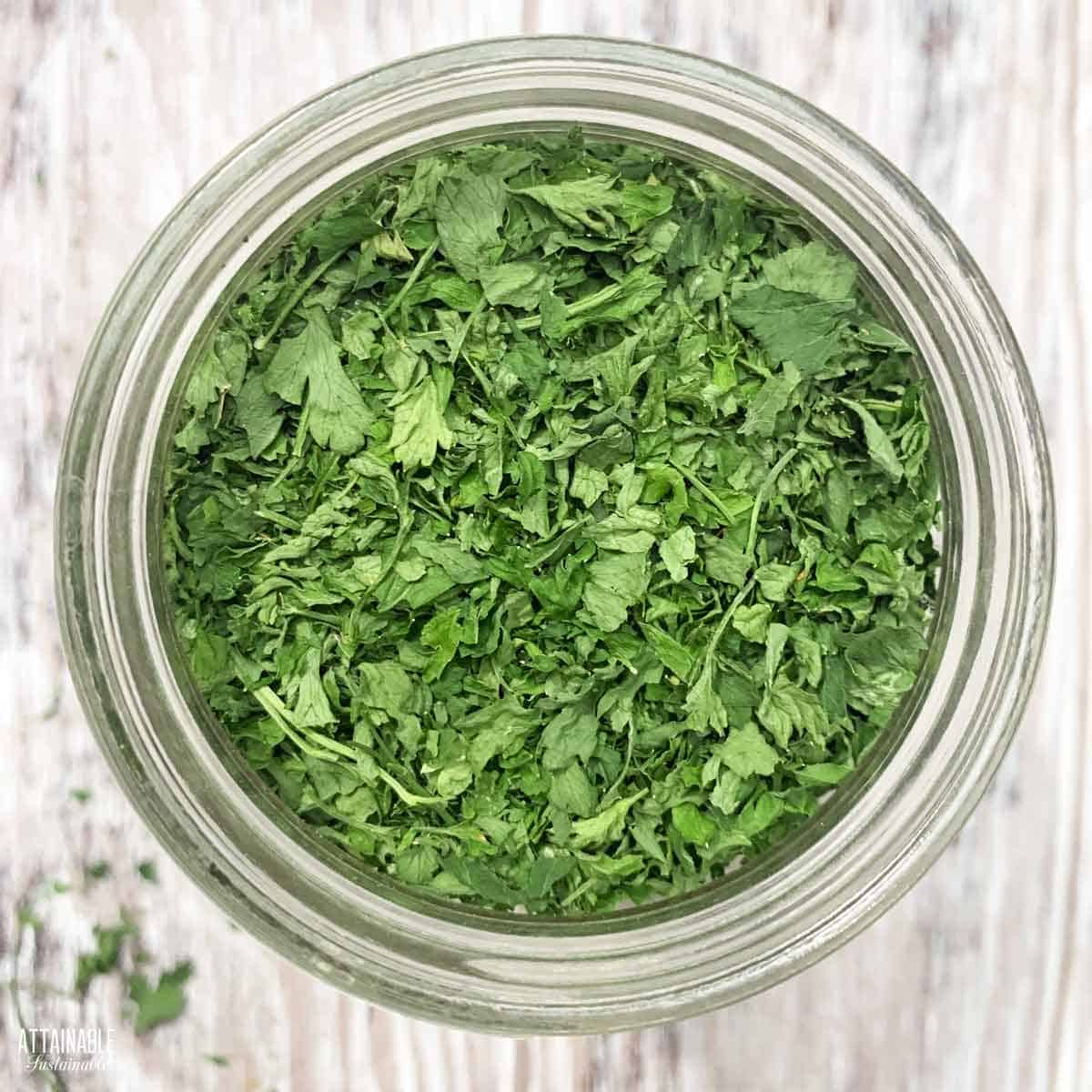
How to Dry Parsley
Ingredients
- Fresh parsley
Instructions
- Prepare parsley by washing and thoroughly drying. Remove most of the stem, leaving behind only the leaves.Fresh parsley
- Place leaves in a single layer on dehydrator trays or a baking sheet lined with a towel. Pack as many as you can onto the trays without overlapping a lot.
Dehydrator:
- Set dehydrator to 95 degrees Fahrenheit or the lowest heat setting - some dehydrators have an “herb” setting. Begin checking parsley after about six hours, though depending on your climate, this can take as much as 8-10 hours.
Oven:
- Turn the oven onto its lowest setting. If yours is a newer oven with a bread proofing setting, use that, otherwise aim for a temperature no higher than 180 degrees Fahrenheit and prop the door open to let some of the heat escape. It will take two to four hours or longer for parsley to completely dry, again, depending on the temperature you use and the humidity. Check it frequently.
Air Drying:
- If your climate is dry and hot, the simplest way to dry parsley leaves is to use what Mother Nature offers up. You can air dry parsley the old-fashioned way if you have the space.
- Cut long stems of parsley and bundle them together using a twist tie or a rubber band.
- Hang parsley to dry on rafters at room temperature, or stretch a length of sturdy line on a fence out of direct sunlight or across the ceiling and use clothespins to hold herbs in place.
Notes
- How long it takes to dehydrate parsley will vary greatly based on the humidity of your region. Parsley is done when it is crunchy and crumbles when you pinch the leaves between your fingers.
- An 8 quart bowl of parsley leaves is enough leaves to fill a 9-tray Excalibur dehydrator and nets about 2 cups of dried parsley. I say about because this depends a lot on how full you pack the leaves in the bowl and how much you are able to fit on the trays.
- Store dried parsley in an airtight container.
